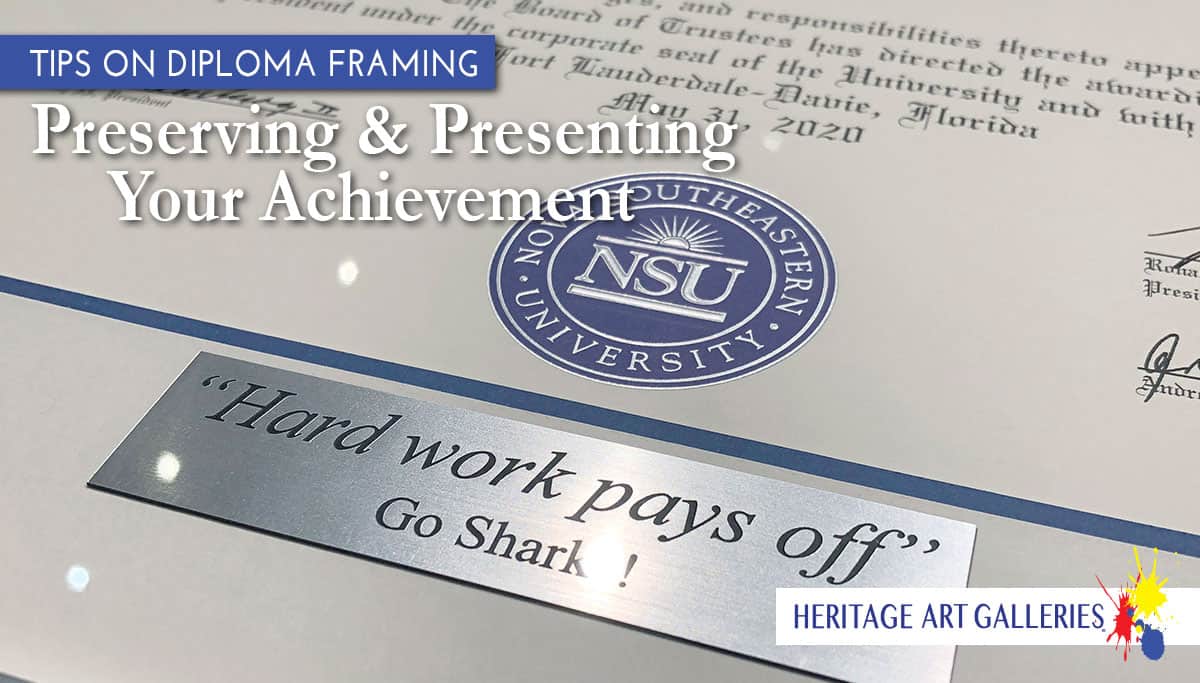We constantly open up clients previously framed artwork and see the work that has been done previously. Sometimes it’s good work, but a lot of the times it is not well done. Today Ian opened up a clients artwork and we wanted to share some information we thought was important about the quality of materials used in custom framing, what to look for and what to avoid.
Transcription:
“Hello, this is Ian at Heritage Art Galleries I just wanted to share with you guys something that we see on the a daily basis as a custom framer. So I had already opened one of this so that is kind of why I am opening another one. We have a piece of artwork here from a client of ours. This is a numbered piece which means there are only a certain amount of them, so this is one there’s 50, and this is 14/50 hand signed by the artist. So this one our client most likely purchased from the artist directly (which we asked her later and she did buy it framed directly from the artist.) And just to share with you guys framing we see from other companies on a daily basis that a lot of times we end up fixing.
So with framing materials there’s two primary categories for matboards which is this big white board on the outside kind of boarding the frame and the artwork itself. So there’s “acid free” and there’s decorative, decorative is a wood pulp based material. Wood pulp has an acidic nature to it, which usually doesn’t mean anything in a day to day life but when you put an acidic surface in contact with art, especially art you personally find valuable either monetarily or emotionally. When you keep that acidic surface in contact with the artwork for 3 years, 5 years, 10 years then it starts to cause damage to the artwork. So it starts to cause the artwork to turn yellow, the paper that was kind of white or off white is more yellow/orange depending on how long it’s been in contact. So anyways this is what i wanted to show you guys, this mat is a decorative or acidic mat and you’re going to say well Ian you’re a custom framer, I don’t know these things.. how do I tell? So I don’t know if I can get this… because of the lights. So there’s a bevel on the board and if the bevel is kind of yellow.. like really yellow or orange then that is a paper or decorative mat. So anyways what I wanted to show you guys is usually when we put together a frame, we just hinge with a linen or rice paper hinge and a releasable water soluble glue, archival, ph neutral, acid free. But a lot of shops… or shops that were in the past, the 70’s 80’s 90’s, shops would glue your artwork would glue your artwork down to the backing board. So the glues often times are also acidic and you can hear the glue cracking. I don’t know if this was done by another shop, there’s no tag on it. The frame looks like it came from a department store so maybe it was something that someone did at home but you can hear the glue on the back of the artwork. The glues been there long enough and it’s not a good quality glue that now it’s dried up and it’s crumbling and falling apart. That’s why I am able to sort of lightly do this (remove it.) Let’s see if we can show this to you. Ok, yeah. So all of that yellow spotting is where the glue touched the paper and now that’s permanent and so ok maybe this artwork is not worth a thousand dollars or ten thousand dollars but if that’s the kind of a job that somebody does…. and you see this is all the glue that’s on the backing, there you go that’s better… if that’s the somebody does then that’s the kind of job they’re doing all the time. So, let’s see, I don’t have a knife on me. So this is the kind of thing we fix on a daily basis, people bring in their artwork it’s been mishandled it’s been put in contact with acidic materials and a lot of times the client will tell me “the framer told me that this was going to be an acid free packaging and acid free frame” and it’s not always the case. But anyways, I just wanted to share with you guys ‘that’ something we do on a daily basis, we reframe peoples artwork. If you see something on your wall and you see that the core is kind of orange and it’s monetarily or emotionally valuable to you then you might consider bringing it in, we could change the matboard which is not expensive, a matboard is $20 and a new backing is $5 and that’s it. So anyways, that’s all for now, take care! Bye.”




